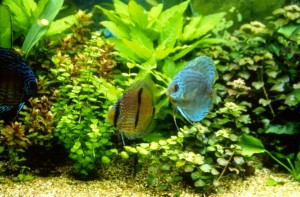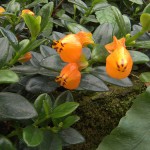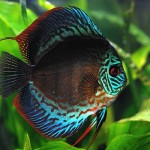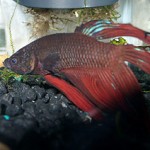Using live plants in an aquarium can create a truly spectacular underwater world people will love to look at. When done poorly, however, you can end up with a muddled mess that makes it difficult to watch your fish. Take the time to plan your aquascape, the way you would plan out your home’s landscape. Different plants are best used in different places in the tank. Here is a list of aquarium plants and where you will want to use them to create the best effect.
Background
You want to use taller plants in the rear of the aquarium, otherwise they will obscure the fish from view. If these plants are used in the back of the landscape, they will provide desirable cover for fish without getting in the way. Plus they will hide unsightly cords, air tubing or filters. Consider these plants:
- Amazon Swords (Echinodorus amazonicus)
- Anacharis (Egeria densa)
- Carolina Fanwort (Cabomba caroliniana)
- Moneywort (Bacopa monnieri)
- Ruffle Plant (Echinodorus martii)
- Wisteria (Hygrophila difformis)
Middle
The middle section of the aquarium is the ideal location for somewhat shorter plants. They are low enough to let the background plants show, but are tall enough to move in the aquarium current, provide interesting places for fish to swim around and through, and create visual interest and additional levels to observe. Consider these plants:
- Cryptocoryne (Cryptocoryne wendtii)
- Dwarf Sagittaria (Sagittaria subulata)
- Java Fern (Microsorum pteropus)
- Madagascar Lace (Aponogeton madagascariensis)
- Water Primrose or Ludwigia (Ludwigia repens)
- Water Sprite (Ceratopteris thalictroides)
Foreground
Plants used in the front of the aquarium should be short, allowing viewers to see all the way into the aquarium. These plants capture the casual observer’s eye and help draw attention to bottom-dwelling fish in the aquarium. Consider these plants:
- Anubius (Anubius barteri or nana)
- Chain Sword (Echinodorus tenellus)
- Dwarf Hairgrass (Eleocharis acicularis)
- Dwarf Swordplant (Echinodorus quadricostatus)
- Glossostigma (Glossostigma elatinoides)
- Micro Sword Grass or Copragrass (Lilaeopsis novae-zelandiae or brasiliensis)
Floating
Plants that float on the surface of the aquarium can create sheltered, low light conditions for fish that need such an environment. Floating plants can also be tied to aquarium decorations and driftwood to create additional interest in the middle or foreground of the tank. Many floating plants grow very rapidly and must be regularly trimmed to keep them from taking over the aquarium or pond where they are used. Consider these plants:
- Fairy Moss (Azolla Caroliniana)
- Java Moss (Vesicularia Dubyana)
- Hornwort (Ceratophyllum demursum)
- Riccia (Riccia Fluitans)
- Water Lettuce (Pistia stratiotes)
Be sure to check with the retailer for details on plants before you buy. Some plants will do well in cool aquariums, others are only suitable for warm tropical tanks. If your fish require low lighting conditions, make sure you buy plants that will thrive without a great deal of light. Also, some plants do better in acidic water conditions while others require an alkaline environment.
If you keep herbivorous fish, you may want to buy a combination of plants your fish will eat and those they won’t in order to provide a fun snack for your fish without sacrificing the beauty of the planted aquarium. Or, buy only plants the fish will leave alone to keep the aquarium looking perfect.
If you buy the right plants for your aquarium conditions, not just the plants that you think look good, then you’ll be able to create a beautiful, healthy aquascape that will thrive in your tank. Otherwise, you’re going to be constantly struggling to keep your plants alive and growing.

















Leave a Reply